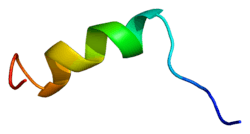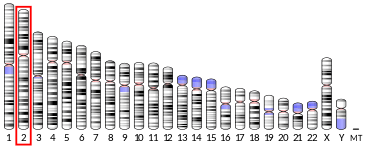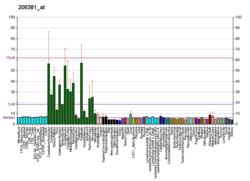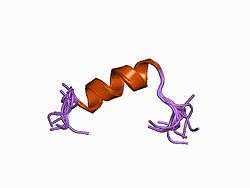Nav1.2
Navα1.2, also known as the sodium channel, voltage-gated, type II, alpha subunit is a protein that in humans is encoded by the SCN2A gene.[5] Functional sodium channels contain an ion conductive alpha subunit and one or more regulatory beta subunits. Sodium channels which contain the Navα1.2 subunit are called Nav1.2 channels.
Function
Voltage-gated sodium channels are transmembrane glycoprotein complexes composed of a large alpha subunit with four domains including 24 transmembrane segments and one or more regulatory beta subunits. They are responsible for the generation and propagation of action potentials in neurons and muscle. This gene encodes one member of the sodium channel alpha subunit gene family. It is heterogeneously expressed in the brain, and mutations in this gene have been linked to several seizure disorders. Several alternatively spliced transcript variants of this gene have been described, but the full-length nature of some of these variants has not been determined.[5]
Clinical significance
Mutations in this gene have been implicated in cases of autism,[6] infantile spasms bitemporal glucose hypometabolism [7], and bipolar disorder.[8]
See also
- Sodium channel
- paralytic - SCN2A ortholog in Drosophila
References
- GRCh38: Ensembl release 89: ENSG00000136531 - Ensembl, May 2017
- GRCm38: Ensembl release 89: ENSMUSG00000075318 - Ensembl, May 2017
- "Human PubMed Reference:". National Center for Biotechnology Information, U.S. National Library of Medicine.
- "Mouse PubMed Reference:". National Center for Biotechnology Information, U.S. National Library of Medicine.
- "Entrez Gene: SCN2A sodium channel, voltage-gated, type II, alpha subunit".
- Sanders SJ, Stephan J.; Murtha MT; Gupta AR; Murdoch JR; Raubeson MJ; Willsey AJ; Ercan-Sencicek AG; et al. (2012). "De novo mutations revealed by whole-exome sequencing are strongly associated with autism". Nature. 485 (7397): 237–241. doi:10.1038/nature10945. PMC 3667984. PMID 22495306.
- Sundaram SK, Chugani HT, Tiwari VN, Huq AH (July 2013). "SCN2A Mutation Is Associated With Infantile Spasms and Bitemporal Glucose Hypometabolism". Pediatr. Neurol. 49 (1): 46–9. doi:10.1016/j.pediatrneurol.2013.03.002. PMC 3868437. PMID 23827426.
- Bipolar Disorder Working Group of the Psychiatric Genomics Consortium; et al. (2019). "Genome-wide association study identifies 30 loci associated with bipolar disorder". Nature Genetics. 51: 793–803. doi:10.1038/s41588-019-0397-8. hdl:10481/58017. PMC 6956732. PMID 31043756.
Further reading
- Catterall WA, Goldin AL, Waxman SG (2006). "International Union of Pharmacology. XLVII. Nomenclature and structure-function relationships of voltage-gated sodium channels". Pharmacol. Rev. 57 (4): 397–409. doi:10.1124/pr.57.4.4. PMID 16382098.
- Lu CM, Han J, Rado TA, Brown GB (1992). "Differential expression of two sodium channel subtypes in human brain". FEBS Lett. 303 (1): 53–8. doi:10.1016/0014-5793(92)80476-W. PMID 1317301.
- Ahmed CM, Ware DH, Lee SC, et al. (1992). "Primary structure, chromosomal localization, and functional expression of a voltage-gated sodium channel from human brain". Proc. Natl. Acad. Sci. U.S.A. 89 (17): 8220–4. doi:10.1073/pnas.89.17.8220. PMC 49889. PMID 1325650.
- Han JA, Lu CM, Brown GB, Rado TA (1991). "Direct amplification of a single dissected chromosomal segment by polymerase chain reaction: a human brain sodium channel gene is on chromosome 2q22-q23". Proc. Natl. Acad. Sci. U.S.A. 88 (2): 335–9. doi:10.1073/pnas.88.2.335. PMC 50805. PMID 1846440.
- Litt M, Luty J, Kwak M, et al. (1989). "Localization of a human brain sodium channel gene (SCN2A) to chromosome 2". Genomics. 5 (2): 204–8. doi:10.1016/0888-7543(89)90047-5. PMID 2571571.
- Bonaldo MF, Lennon G, Soares MB (1997). "Normalization and subtraction: two approaches to facilitate gene discovery". Genome Res. 6 (9): 791–806. doi:10.1101/gr.6.9.791. PMID 8889548.
- Lu CM, Eichelberger JS, Beckman ML, et al. (1999). "Isolation of the 5'-flanking region for human brain sodium channel subtype II alpha-subunit". J. Mol. Neurosci. 11 (3): 179–82. doi:10.1385/JMN:11:3:179. PMID 10344788.
- Baulac S, Gourfinkel-An I, Picard F, et al. (2000). "A Second Locus for Familial Generalized Epilepsy with Febrile Seizures Plus Maps to Chromosome 2q21-q33". Am. J. Hum. Genet. 65 (4): 1078–85. doi:10.1086/302593. PMC 1288241. PMID 10486327.
- Schade SD, Brown GB (2001). "Identifying the promoter region of the human brain sodium channel subtype II gene (SCN2A)". Brain Res. Mol. Brain Res. 81 (1–2): 187–90. doi:10.1016/S0169-328X(00)00145-5. PMID 11000491.
- Kasai N, Fukushima K, Ueki Y, et al. (2001). "Genomic structures of SCN2A and SCN3A - candidate genes for deafness at the DFNA16 locus". Gene. 264 (1): 113–22. doi:10.1016/S0378-1119(00)00594-1. PMID 11245985.
- Malacarne M, Gennaro E, Madia F, et al. (2001). "Benign Familial Infantile Convulsions: Mapping of a Novel Locus on Chromosome 2q24 and Evidence for Genetic Heterogeneity". Am. J. Hum. Genet. 68 (6): 1521–6. doi:10.1086/320596. PMC 1226140. PMID 11326335.
- Sugawara T, Tsurubuchi Y, Agarwala KL, et al. (2001). "A missense mutation of the Na+ channel αII subunit gene Nav1.2 in a patient with febrile and afebrile seizures causes channel dysfunction". Proc. Natl. Acad. Sci. U.S.A. 98 (11): 6384–9. doi:10.1073/pnas.111065098. PMC 33477. PMID 11371648.
- Heron SE, Crossland KM, Andermann E, et al. (2002). "Sodium-channel defects in benign familial neonatal-infantile seizures". Lancet. 360 (9336): 851–2. doi:10.1016/S0140-6736(02)09968-3. PMID 12243921.
- Strausberg RL, Feingold EA, Grouse LH, et al. (2003). "Generation and initial analysis of more than 15,000 full-length human and mouse cDNA sequences". Proc. Natl. Acad. Sci. U.S.A. 99 (26): 16899–903. doi:10.1073/pnas.242603899. PMC 139241. PMID 12477932.
- Weiss LA, Escayg A, Kearney JA, et al. (2003). "Sodium channels SCN1A, SCN2A and SCN3A in familial autism". Mol. Psychiatry. 8 (2): 186–94. doi:10.1038/sj.mp.4001241. PMID 12610651.
- Yu FH, Westenbroek RE, Silos-Santiago I, et al. (2003). "Sodium channel beta4, a new disulfide-linked auxiliary subunit with similarity to beta2". J. Neurosci. 23 (20): 7577–85. doi:10.1523/JNEUROSCI.23-20-07577.2003. PMC 6740763. PMID 12930796.
- McEwen DP, Meadows LS, Chen C, et al. (2004). "Sodium channel beta1 subunit-mediated modulation of Nav1.2 currents and cell surface density is dependent on interactions with contactin and ankyrin". J. Biol. Chem. 279 (16): 16044–9. doi:10.1074/jbc.M400856200. PMID 14761957.
- Kamiya K, Kaneda M, Sugawara T, et al. (2004). "A nonsense mutation of the sodium channel gene SCN2A in a patient with intractable epilepsy and mental decline". J. Neurosci. 24 (11): 2690–8. doi:10.1523/JNEUROSCI.3089-03.2004. PMC 6729532. PMID 15028761.
- Berkovic SF, Heron SE, Giordano L, et al. (2004). "Benign familial neonatal-infantile seizures: characterization of a new sodium channelopathy". Ann. Neurol. 55 (4): 550–7. doi:10.1002/ana.20029. PMID 15048894.
- Pereira S, Vieira JP, Barroca F, et al. (2004). "Severe epilepsy, retardation, and dysmorphic features with a 2q deletion including SCN1A and SCN2A". Neurology. 63 (1): 191–2. doi:10.1212/01.wnl.0000132844.20654.c1. PMID 15249644.
External links
- SCN2A+protein,+human at the US National Library of Medicine Medical Subject Headings (MeSH)
- Overview of all the structural information available in the PDB for UniProt: Q99250 (Sodium channel protein type 2 subunit alpha) at the PDBe-KB.
This article incorporates text from the United States National Library of Medicine, which is in the public domain.






